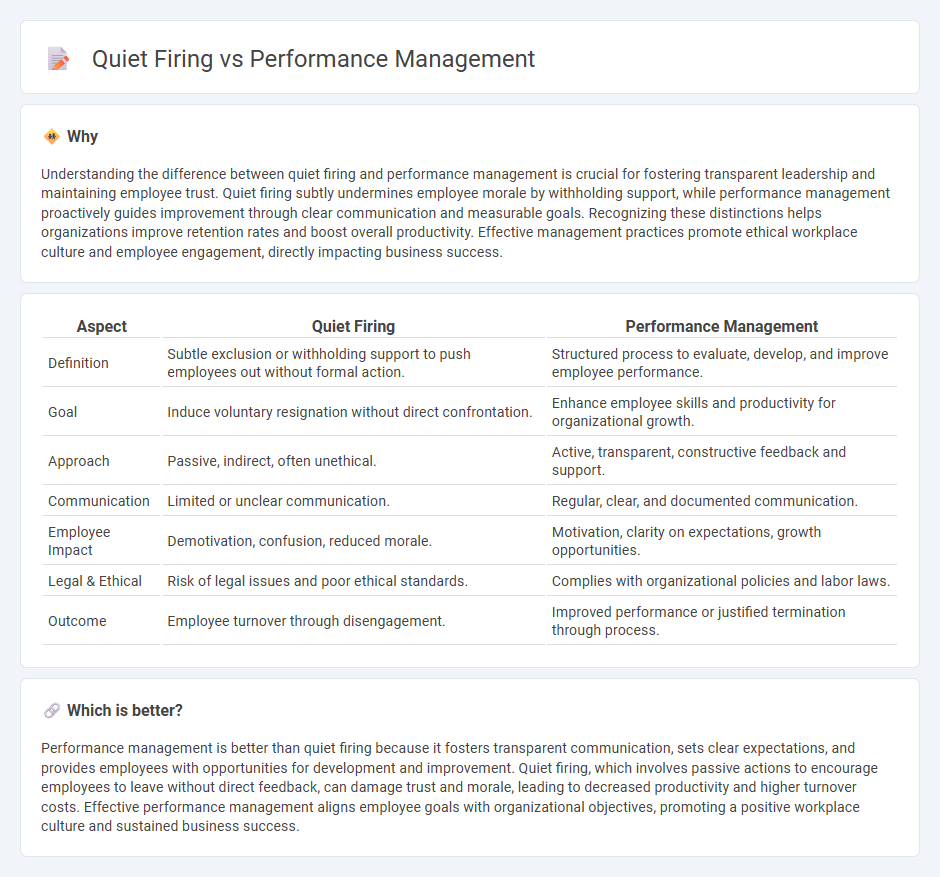
Quiet firing involves subtly pushing employees out by reducing responsibilities or ignoring their contributions, while performance management focuses on structured feedback and development to improve employee outcomes. Performance management employs clear goals, regular evaluations, and targeted support to enhance productivity and engagement. Explore the key differences and strategies to effectively manage team performance.
Why it is important
Understanding the difference between quiet firing and performance management is crucial for fostering transparent leadership and maintaining employee trust. Quiet firing subtly undermines employee morale by withholding support, while performance management proactively guides improvement through clear communication and measurable goals. Recognizing these distinctions helps organizations improve retention rates and boost overall productivity. Effective management practices promote ethical workplace culture and employee engagement, directly impacting business success.
Comparison Table
| Aspect | Quiet Firing | Performance Management |
|---|---|---|
| Definition | Subtle exclusion or withholding support to push employees out without formal action. | Structured process to evaluate, develop, and improve employee performance. |
| Goal | Induce voluntary resignation without direct confrontation. | Enhance employee skills and productivity for organizational growth. |
| Approach | Passive, indirect, often unethical. | Active, transparent, constructive feedback and support. |
| Communication | Limited or unclear communication. | Regular, clear, and documented communication. |
| Employee Impact | Demotivation, confusion, reduced morale. | Motivation, clarity on expectations, growth opportunities. |
| Legal & Ethical | Risk of legal issues and poor ethical standards. | Complies with organizational policies and labor laws. |
| Outcome | Employee turnover through disengagement. | Improved performance or justified termination through process. |
Which is better?
Performance management is better than quiet firing because it fosters transparent communication, sets clear expectations, and provides employees with opportunities for development and improvement. Quiet firing, which involves passive actions to encourage employees to leave without direct feedback, can damage trust and morale, leading to decreased productivity and higher turnover costs. Effective performance management aligns employee goals with organizational objectives, promoting a positive workplace culture and sustained business success.
Connection
Quiet firing subtly undermines employee motivation by withholding support and growth opportunities, directly impacting performance management outcomes. Effective performance management relies on transparent communication and clear expectations, which quiet firing bypasses, leading to decreased productivity and engagement. Organizations that address quiet firing practices improve performance management by fostering an environment of trust and accountability.
Key Terms
Performance Management:
Performance management involves systematic processes aimed at improving employee productivity and aligning their goals with organizational objectives through regular feedback, goal setting, and development plans. It emphasizes transparent communication and constructive support to foster growth, as opposed to quiet firing which subtly undermines employee engagement without direct confrontation. Discover comprehensive strategies to implement effective performance management for enhanced workforce success.
Goal Setting
Performance management emphasizes clear, measurable goal setting to align employee efforts with organizational objectives, fostering transparency and continuous feedback. Quiet firing, in contrast, often neglects explicit goal definitions, leaving employees uncertain about expectations and progress, which can undermine motivation and engagement. Explore how effective goal setting can counteract quiet firing and enhance workforce productivity.
Feedback
Performance management centers on continuous, transparent feedback to help employees enhance skills and meet organizational goals, fostering growth and accountability. Quiet firing involves minimal communication and subtle exclusion, leading to decreased morale and unclear expectations. Explore how transparent feedback can transform workplace culture and prevent quiet firing practices.
Source and External Links
What Is Performance Management? The Complete Guide - This guide provides an overview of performance management as an ongoing process for assessing job responsibilities and fostering employee growth through methods like goal setting and continuous feedback.
What is performance management? HR guide - This guide defines performance management as a process where managers provide feedback to align employee performance with organizational goals, focusing on both measurement and development.
Performance Management - KU's Human Resources - Describes performance management as an ongoing process involving communication, goal setting, and development planning to optimize individual performance and align with strategic organizational goals.
 dowidth.com
dowidth.com